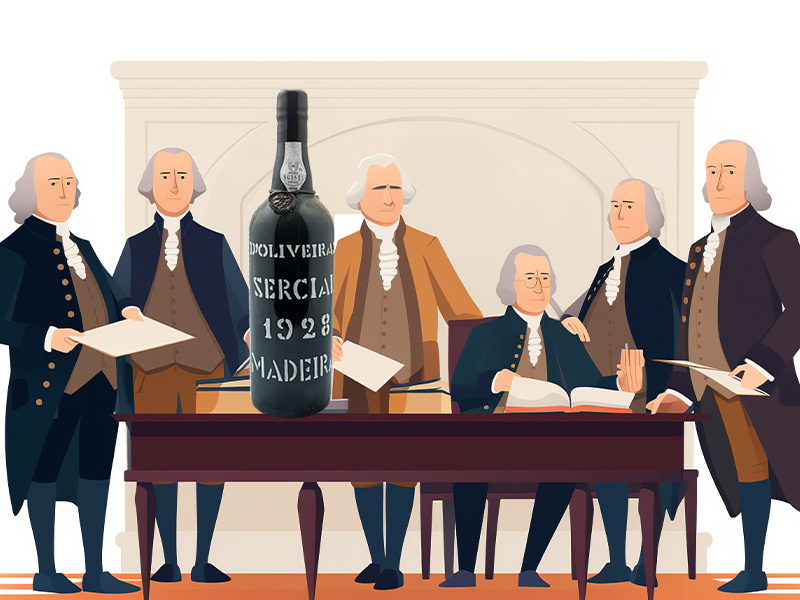Founding Fathers Loved Madeira

The founding fathers, to include George Washington, Tomas Jefferson, and Benjamin Franklin, were known to have enjoyed Madeira wine, as it was a popular choice of alcohol among the upper class, Colonial Americans in the 18th Century. It was a sophisticated and luxurious drink for the elites of the time. Historical records and letters by these individuals would mention their appreciation for Madeira. Most ironically Madeira was the celebratory drink at the signing of the Declaration of Independence.
Madeira is a Portuguese island in the Atlantic Ocean, about 375 miles off the coast of Morocco. And the fortified wine made there is of the same name. The island was discovered in 1419 and was fist colonized by Portuguese merchants. Initially, the island’s main production was that of sugar, with smaller amounts of wheat and wine for export. During the 17th and 18th centuries, sugar production fell as the Caribbean Islands became more competitive.
Out of the decline in sugar sales came the growth of the wine industry. British merchants would arrive in Madeira and take wine to the North American and West Indies colonies. The wine was put into oak barrels that were then loaded on the wooden ships in the hull and used as a ballast for these long journeys. Oak barrels allow for a minor amount of oxygen to seep into the wine causing a slow oxidation of the wine to occur. As ships pitch and roll out to sea, so did the barrels in the hold. As trade would take the British ships to the tropics, the hold would get rather warm, and be held at a warm temperature for significant lengths of time. What was discovered was that when the wine endured this, it actually improved its quality, with a side benefit of making the wine a bit indestructible—meaning that in most cases you would not hold your wine in an oxidized, constant moving, hot situation without spoilage. The fact that it became more durable meant that it would survive lengthy voyages. The fact that it improves in quality meant the demand for it increased, driving an industry for the Portuguese.
Madeira is a tiny little, mountainous island where the soil is very fertile, with mostly volcanic sediments. Overall, the island experiences a warm Mediterranean climate. Precipitation mainly comes in the fall and winter months, to the tune of about 3,000mm per year, which is an overabundance in wine-vine terms. This means that elevation is the key for growing grapes for a balanced wine, as the height and slope will 1st drain water quickly away, and 2nd will have a cooler average temperature. Grapes here include Tinta Negra, Sercial, Verdelho (which also grows in Spain), Boal, Malmsey (also known as Malvasia), and Terrantez. Each of which have their own special needs as some grow better at higher altitudes (need the cold) and other at lower (need the heat).
As far as winemaking goes, it starts out in the normal way. The fruit is brought into the winery and checked for weight (amount of juice), health, and sugar brix level (amount of alcohol can be converted), then off to destemming and crushing. Fermentation is done in stainless steel vessels. Like with the world of Sherries, timing of fortification may differ depending on style looking to be accomplished. If looking for a sweet Madeira, fortification may happen early in the fermentation, when the juice reaches say four or five percent ABV, then brandy is added so that the ABV is raised to 17-18 percent, thus killing all the yeast. Some Madera is meant to be dry, and fortification happens at the end of fermentation. But even being dry, these wines will still have a bit of sweetness.
The aging process is a big departure from when it was first made in the 17th and 18th century. Apparently, wine is not carried around in wooden ships anymore. So, in order to replicate the hot, oxidative condition, there are two methods available: Estufagem and Canteiro. Estufagem involves heating the wine in stainless steel tanks or heated rooms for a shorter period, typically a few months. This process accelerates the aging and oxidation of the wine. Canteiro, on the other hand, involves aging the wine slowly and naturally, in barrels placed in warm attics for several years or even decades.
Madeira offers multiple ways to enjoy it. Sip it straight, relishing its complex flavors and aromas in small tulip-shaped glasses. It also serves as a delightful dessert wine, pairing well with cakes, pastries, and chocolates to enhance their flavors. As an aperitif, drier Madeira varieties like Sercial or Verdelho can be chilled and savored before a meal, stimulating the appetite with their crisp acidity and subtle sweetness. Additionally, Madeira can be a valuable ingredient in cocktails, providing depth and complexity akin to fortified wines like sherry or port. Explore mixing Madeira into cocktails or trying recipes specifically featuring this wine. Lastly, Madeira's rich flavors make it versatile in cooking, elevating savory dishes, such as meat or game sauces, and it is frequently utilized in traditional recipes, like Madeira cake or Madeira sauce.
Happy 4th of July!

Comments
Be the first to comment...